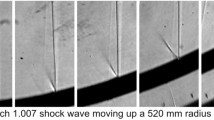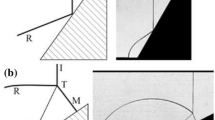Abstract
The present study aims to investigate the reflection and refraction of a curved shock front as it slides along an air–water interface, using the time-resolved shadowgraph technique. The curved shock front is generated from a free-piston shock tube. The study successfully captured the propagation of a refracted shock wave in water along with that of the reflected shock wave in the air. The refracted shock moves much faster than the incident shock due to a higher acoustic speed in the water. It is seen that the reflected shock initially exhibits a regular reflection (RR), which then transitions to a Mach reflection (MR) as it propagates along the interface. As the shock wave propagates along the air–water interface, the incident shock wave angle with the interface keeps on increasing, leading to RR–MR transition. Shock polar analysis shows that as the Mach reflection structure propagates further along the interface, it transitions from a standard Mach reflection to a non-standard Mach reflection. It is seen that the distance the shock wave propagates along the interface before it transitions from RR to MR increases with the increase in the interface distance (distance between the water surface and the shock tube axis). It is also found that the reflection surface (water or solid) does not seem to have a significant effect on the shock transition criterion, especially the distance at which the shock wave transitions from RR to MR.


















Similar content being viewed by others
Data Availability
The data that support the findings of this study are available from the corresponding author upon reasonable request.
References
Von Neumann, J.: Refraction, intersection and reflection of shock waves. NAVORD Report 203-245 (1945)
Hornung, H.G., Oertel, H., Sandeman, R.J.: Transition to Mach reflexion of shock waves in steady and pseudosteady flow with and without relaxation. J. Fluid Mech. 90(3), 541–560 (1979). https://doi.org/10.1017/S002211207900238X
Semenov, A.N., Berezkina, M.K., Krassovskaya, I.V.: Classification of pseudo-steady shock wave reflection types. Shock Waves 22, 307–316 (2012). https://doi.org/10.1007/s00193-012-0373-z
Delius, M.: Medical applications and bioeffects of extracorporeal shock waves. Shock Waves 4, 55–72 (1994). https://doi.org/10.1007/BF01418569
Flores, J., Holt, M.: Shock wave interactions with the ocean surface. Phys. Fluids 25, 238–246 (1982). https://doi.org/10.1063/1.863753
Ben-Dor, G.: Shock Wave Reflection Phenomena, 2nd edn. Springer, Berlin (2007). https://doi.org/10.1007/978-3-540-71382-1
Henderson, L.F., Lozzi, A.: Experiments on transition of Mach reflexion. J. Fluid Mech. 68(1), 139–155 (1975). https://doi.org/10.1017/S0022112075000730
Ben-Dor, G.: A reconsideration of the three-shock theory for a pseudo-steady Mach reflection. J. Fluid Mech. 181, 467–484 (1987). https://doi.org/10.1017/S0022112087002179
Takayama, K., Ben-Dor, G., Gotoh, J.: Regular to Mach reflection transition in truly nonstationary flows—influence of surface roughness. AIAA J. 19, 1238–1240 (1981). https://doi.org/10.2514/3.7852
Ram, O., Geva, M., Sadot, O.: High spatial and temporal resolution study of shock wave reflection over a coupled convex–concave cylindrical surface. J. Fluid Mech. 768, 219–239 (2015). https://doi.org/10.1017/jfm.2015.80
Kleine, H., Timofeev, E., Hakkaki-Fard, A., Skews, B.: The influence of Reynolds number on the triple point trajectories at shock reflection off cylindrical surfaces. J. Fluid Mech. 740, 47–60 (2014). https://doi.org/10.1017/jfm.2013.634
Ben-Dor, G., Takayama, K.: Analytical prediction of the transition from Mach to regular reflection over cylindrical concave wedges. J. Fluid Mech. 158, 365–380 (1985). https://doi.org/10.1017/S0022112085002695
Itoh, S., Okazaki, N., Itaya, M.: On the transition between regular and Mach reflection in truly non-stationary flows. J. Fluid Mech. 108, 383–400 (1981). https://doi.org/10.1017/S0022112081002176
Geva, M., Ram, O., Sadot, O.: The regular reflection \(\rightarrow \) Mach reflection transition in unsteady flow over convex surfaces. J. Fluid Mech. 837, 48–79 (2018). https://doi.org/10.1017/jfm.2017.835
Vignati, F., Guardone, A.: Transition from regular to irregular reflection of cylindrical converging shock waves over convex obstacles. Phys. Fluids 29, 116104 (2017). https://doi.org/10.1063/1.4989384
Kleine, H., Timofeev, E., Takayama, K.: Reflection of blast waves from straight surfaces. In: Jiang, Z. (ed.) Shock Waves. Springer, Berlin (2005)
Dewey, J., Mcmillin, D., Classen, D.: Photogrammetry of spherical shocks reflected from real and ideal surfaces. J. Fluid Mech. 81(4), 701–717 (1977). https://doi.org/10.1017/S0022112077002304
Hu, T.C.J., Glass, I.I.: Blast wave reflection trajectories from a height of burst. AIAA J. 24, 607–610 (1986). https://doi.org/10.2514/3.9314
Henderson, L.F., Ma, J.H., Sakurai, A., Takayama, K.: Refraction of a shock wave at an air–water interface. Fluid Dyn. Res. 5, 337–350 (1990). https://doi.org/10.1016/0169-5983(90)90003-H
Henderson, L.F.: On the refraction of shock waves. J. Fluid Mech. 198, 365–386 (1989). https://doi.org/10.1017/S0022112089000170
Henderson, L.F.: On shock impedance. J. Fluid Mech. 40(4), 719–735 (1970). https://doi.org/10.1017/S002211207000040X
Borisov, A.A., Gelfand, B.E., Sherpanev, S., Timofeev, E.I.: Mechanism for mixture formation behind a shock sliding over a fluid surface. Combust. Explos. Shock Waves 17, 86–93 (1981). https://doi.org/10.1007/BF00798146
Teodorczyk, A., Shepherd, J.E.: Interaction of a shock wave with a water layer. Technical Report FM2012-002, California Institute of Technology, USA (2012)
Rodriguez, V., Jourdan, G., Marty, A., Allou, A., Parisse, J.D.: Planar shock wave sliding over a water layer. Exp. Fluids 57, 125–130 (2016). https://doi.org/10.1007/s00348-016-2217-6
Takayama, K., Ben-Dor, G.: Pseudo-steady oblique shock wave reflections over water wedges. Exp. Fluids 8, 129–136 (1989). https://doi.org/10.1007/BF00195786
Wan, Q., Jeon, H., Deiterding, R., Eliasson, V.: Numerical and experimental investigation of oblique shock wave reflection off a water wedge. J. Fluid Mech. 826, 732–758 (2017). https://doi.org/10.1017/jfm.2017.452
Kleine, H., Timofeev, E., Voinovich, P., Takayama, K.: Blast wave reflection from solid, liquid, and gaseous surfaces. In: Lu, F. (ed.) Proceedings on 23rd ISSW, Paper 1903, CD-ROM Proceedings (2002)
Sembiana, S., Liverts, M., Tillmark, N., Apazidis, N.: Plane shock wave interaction with a cylindrical water column. Phys. Fluids 28, 056102 (2016). https://doi.org/10.1063/1.4948274
Hosseini, H., Moosavi-Nejad, S., Akiyama, H., Menezes, V.: Shock wave interaction with interfaces between materials having different acoustic impedances. Appl. Phys. Lett. 104, 103701 (2014). https://doi.org/10.1063/1.4867883
Colella, P., Henderson, L.F.: The von Neumann paradox for the diffraction of weak shock waves. J. Fluid Mech. 213, 71–94 (1990). https://doi.org/10.1017/S0022112090002221
Vasilev, E.I., Kraiko, A.N.: Numerical simulation of weak shock diffraction over a wedge under the von Neumann paradox conditions. USSR Comput. Math. Math. Phys. 39, 1335 (1999)
Guderly, K.G.: Consideration of the structure of mixed subsonic-supersonic flow patterns. Technical Report F-TR-2168-ND, Wright Field, USA (1947)
Vasilev, E.I., Elperin, T., Ben-Dor, G.: Analytical reconsideration of the von Neumann paradox in the reflection of a shock wave over a wedge. Phys. Fluids 20, 046101 (2008). https://doi.org/10.1063/1.2896286
Acknowledgements
The authors gratefully acknowledge the financial support for this project from the INSPIRE Grant (Grant No. DST/INSPIRE/04/2018/001780), Department of Science and Technology (DST), India.
Funding
Funding was provided by INSPIRE Grant, Department of Science and Technology, India (Grant No. IFA18-ENG251).
Author information
Authors and Affiliations
Corresponding author
Additional information
Communicated by A. Sasoh.
Publisher's Note
Springer Nature remains neutral with regard to jurisdictional claims in published maps and institutional affiliations.
Appendix
Appendix
In the present study, the shock wave angle and shock Mach number were computed from the shadowgraph images through image processing. In order to determine the shock profile from the raw image, the Canny edge detection algorithm (using MATLAB platform) was used. From the edge detection algorithm, the pixel values at the shock front can be found. Figure 18a shows the raw image, and Fig. 18b shows the corresponding processed image using the Canny algorithm. The pixel values from the processed image can then be used to locate the shock position at various time intervals. For the reconstruction of the shock profile, the pixel locations at the shock front need to be converted to their corresponding physical distance from a reference frame. This is done by computing the physical dimension represented by each pixel (millimeters per pixel) for a particular experiment. In order to compute the value of millimeters per pixel, the shadowgraph images of a measuring scale with a known length (38 mm width) were captured prior to each experiment. From this, the number of pixels representing the image of the measuring scale can be computed, which in turn can be used to compute the value of millimeters per pixel. In the present study, one pixel is found to represent a physical dimension of 0.76 mm.
An illustration of this is shown in Fig. 18c. The position of the shock front is then computed by multiplying the pixel value at the shock front with the value of millimeters per pixel. A typical reconstructed shock profile for the experiment with the case-2 condition is shown in Fig. 18d. The shock speed (v) is then found by noting the shock propagation distance between two frames (by counting the change in pixel location of the shock front in the two frames) and the interframe time which is available from the frames per second (interframe time, \(t=1/\hbox {fps}\)). From the shock speed, the shock wave Mach number can be easily computed (\(M_{\mathrm{s}}=v/c\)). For determining the shock wave angle, the pixel locations at the shock front close to the interface are extracted from the images (shock front in the limit of only 3-pixel height are considered). A linear curve fitting was employed to reconstruct the small portion of the shock front close to the interface, which in turn can be used to determine the shock wave angle. It is expected that the linear curve fitting assumption close to the interface is valid since an infinitesimal portion of any general curve can be represented as a linear curve.
In the present study, it is assumed that the shock front lies at the center point of the pixel representing the shock front. However, this consideration leads to an error of ± 0.5 pixels in the measurement since the shock front can be at any point in the pixel representing the shock front. This error was accounted for in the Mach number measurements from the images by computing the uncertainty in position determination from the images. The uncertainty in position determination from the images corresponds to the physical distance represented by ± 0.5 pixels. In order to estimate the repeatability and the error in shock wave angle measurements, the experiment for each water-level case was repeated at least three times. The shock wave angles are then measured from each of these experiments. The error in shock wave angle measurement is computed from the standard deviation from the measured values from each of these experiments.
The triple-point Mach number (\(M_{\mathrm{s}}\)) and the triple-point trajectory have also been computed from image processing, as shown in Fig. 19. The value of \(M_{\mathrm{s}}\) is computed by tracking the triple-point location at various time steps. The x-coordinate of the triple point at various time steps is tracked from the pixel values. From the x-coordinates, the distance moved by the triple point in the x-direction (\(x_{1}\)–\(x_{2}\)) can be computed, as shown in Fig. 19a and b. From this, the triple-point Mach number along the x-direction (\(M_{\mathrm{s}}\)) can be computed as \(M_{\mathrm{s}}=\frac{\Delta \,x}{\Delta t\,{a}_{\mathrm {s}}}\), where \(a_{\mathrm{s}}\) is the acoustic speed upstream to the incident shock wave and \(\Delta t\) is the interframe time step. The incident shock angle with respect to the triple-point trajectory (\(\phi _{1}\)) at each time step can be computed by reconstructing the incident shock profile and the triple-point trajectory using image processing. The triple-point trajectory can be reconstructed by computing the x- and y-coordinates of the triple point at various time instants. The slope of the triple-point trajectory at any particular time instant gives the angle \(\chi \) with respect to the x-direction. Similarly, the shock wave angle (\(\phi _{\mathrm{s}}\)) with respect to the x-direction can be computed from the processed images. The difference between the angles \(\phi _{\mathrm{s}}\) and \(\chi \) gives the incident shock angle with respect to the triple-point trajectory at a particular time instant. A schematic representation of this is shown in Fig. 19c.
Rights and permissions
Springer Nature or its licensor holds exclusive rights to this article under a publishing agreement with the author(s) or other rightsholder(s); author self-archiving of the accepted manuscript version of this article is solely governed by the terms of such publishing agreement and applicable law.
About this article
Cite this article
Arun Kumar, R., Rajesh, G. & Jagadeesh, G. The reflection and refraction of a curved shock front sliding over an air–water interface. Shock Waves 32, 497–515 (2022). https://doi.org/10.1007/s00193-022-01097-z
Received:
Revised:
Accepted:
Published:
Issue Date:
DOI: https://doi.org/10.1007/s00193-022-01097-z





